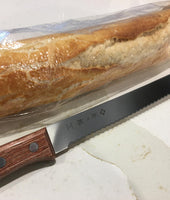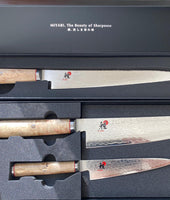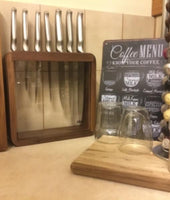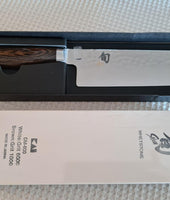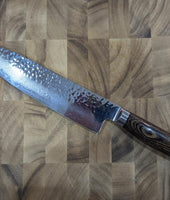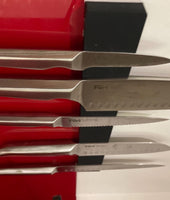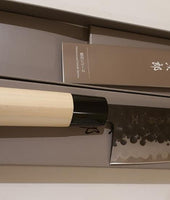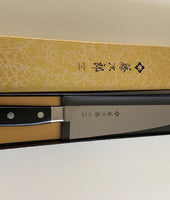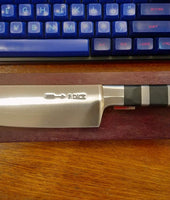Butcher Knife Set - Each of the Knives
A stainless steel butcher knife set comprises of a range of knives for cutting and carving meat into its final form.
A butcher knife is what you would typically see in the meat processing trade. They are used for splitting, stripping, and cutting primary meat cuts into sizeable cuts for buyers.
These knives are characterised by their large, thick, curved front and are used in combination with a boning knife to turn carcasses and large chunks of meat into primal cuts.
A butcher knife is typically too wide for boning, too stiff for filleting, too long for caping, and too straight for skinning. So it is often used in combination with other derivatives of the butcher’s knife such as the boning knife, carving knife, skinning knife, and cleaver which specialise in specific tasks.
Boning knife
Helps cutting and slicing meats from bones, fish, poultry. They are characterised by having a flexible, thin long blade.
With either a straight or curved blade depending on its application, the blade is also thinner compared to a carving knife giving way for increased maneuverability to cut around bones and sinew.
Chef knife
The chef knife is a multi-purpose knife designed to perform well at a number of tasks as opposed to specialising in any one purpose. Variations typically seen are the German/French/Japanese chef butcher knives.
Used for mincing, slicing meat, chopping vegetables and disjointing large cuts. A must have in any kitchen.
Carving knife
They are designed specifically for carving out the exact quantity and quality of meat and are characterised by having a sharp point. With a long thin blade, this knife will cut through cartilage with relative ease in order to get as much meat as possible.
The blade on a carving knife is typically wider, making it easier to keep the direction of the cuts straight and they often have scalloped edges to avoid any food sticking to the blade while cutting.
Carving knives are mostly used for food preparations as their large edges make it more quick and convenient to accomplish kitchen tasks. They are used to slice thin cuts of meat, including roasts, ham, poultry, and other cooked meats.
Slicing Knife
A knife used to cut slices of cooked or smoked meat, poultry, and fish. The blade on a Slicing knife is long (typically 8 to 12 inches in length), thin, and constructed with either a round or pointed tip.
Depending on the manufacturer and brand, the blade may be flexible or rigid, depending on the type of food being sliced.
Flexible blades are made for firmer fleshed food items, such as dry sausages or prosciutto, while rigid blades are made for fleshed items with a more moist texture, such as baked hams.
Filleting knife
A ‘fillet’ is a fleshy boneless piece of meat, so it only goes to say that a fillet knife is used for removing bones, cartilage, and skin from meat. You will often see many filleting knives with ‘flex’ to make it that much easier and quicker for your blade to navigate around bones and joints, and it slices exactly where you want it to.
The result? You’ll end up with more food and less waste.
Due to the good control when picking out bones and removing skin and cartilage, fillet knives are often used for filleting fish. The blade on fillet knives is typically 15-28cm long, making them perfect for moving easily along the backbone and under the skin of a fish.
Skinning knife
Typically a skinning knife has wide, short blade. The edge is strong and does not have much flexibility or spring. Skinning knives are more of a hunting tool.
These knives are used for removing animal skin from the meat and has a very fine and keen blade for this purpose.
Cleaver
Cleavers are generally used as a kitchen or butcher knife for hacking through meat and bone. They are large knives that vary in shape but most often than not resemble a rectangular bladed hatchet.
The broadside can be used for crushing when preparing foods such as garlic.
Compared to other kitchen knives, the blade on cleaver comes with especially tough edges meant to withstand repeated blows into thick meat, dense cartilage, and hacking through bone, as well as withstanding the cutting board underneath.
This toughness is achieved by using softer, tougher steel and a thick blade. By having harder steel or thinner blade when hacking through meat or bone may cause the blade to break under enormous pressure.
When in use, it is swung like a hammer or meat tenderiser. The design of the knife – with its sheer weight and wide lade relies on sheer momentum to cut through easily and efficient, chopping right through rather than slicing in a back and forwards motion.
As the momentum relies on how strong the user swings as well as the weight of the blade, the edge of a cleaver does not need to be that sharp. On the contrary, having a sharp edge is not ideal.

Scimitar
A schimitar (sometimes spelled cimiter) are large, wide curved versions of the butcher's knife, with a blade typically around 20-35cm in length.
They are stiff knives with no flex, with a curved shape to help create a longer slicing area allowing for a greater range for each slicing motion.
It is used primarily for cutting large pieces of meat into retail cuts such as steaks.
In Conclusion
There are many types of butcher knives depending on the task at hand. If you are slicing cooked meat then a carving knife would be appropriate. Chopping thick chunks of raw meat? Then a cleaver is your go-to knife. Need to weave around bones and cartilage? Then a boning knife or filleting knife is up for the job depending on what you are cutting.
Being prepared and having the right tools makes all the difference when cutting and preparing your food. Make sure you have the best tools for the job by shopping our range of premium grade knives now.
Explore More Products: FELIX Combination Whetstone #400/1000 | FELIX Diamond Sharpening Steel 26cm | FELIX First Class Carving Fork 16cm

Tradition meets Modernity
The exclusive designer series “1905” combines tradition and innovation. Friedr. Dick already developed this extraordinary knife with solid bolsters in the year 1905

Long lasting cutting edge
The blade is well sharpened and optimally balanced and consists of the high-end chromium steel “XCrMoVMn”. The embossing completes the classically modern design of the series.

Absolute sharpness
Thanks to double sharpening and polishing process and laser-tested geometry of the cutting edge, cutting with these knives is not just a pleasure but an art

High quality hygienic handle
High-quality, injection-molded gap-free, hygienic polypropylene handle with distinctive steel rings

The Professionals Only Choice
Friedr. Dick is well known to professional chefs around the world as the leading innovator in its field. Its international reputation as a manufacturer of quality utensils is based on the consistent reliability and longevity life of our products.

Sebastian Frank
Winner "Koch des Jahres 2011" | Executive chef restaurant Horváth (Berlin)
"My first set of knives during my apprenticeship was, and still is, made by F. DICK. As a chef I have to do my work precisely and steadily. Thus, I need high-quality cutting tools that lie good in hand and stay sharp for a long time. The wide product range of F. DICK offers the right tool for each kind of work."
Also Read: Wooden Knife Block - How to Clean in 9 Simple Steps





























